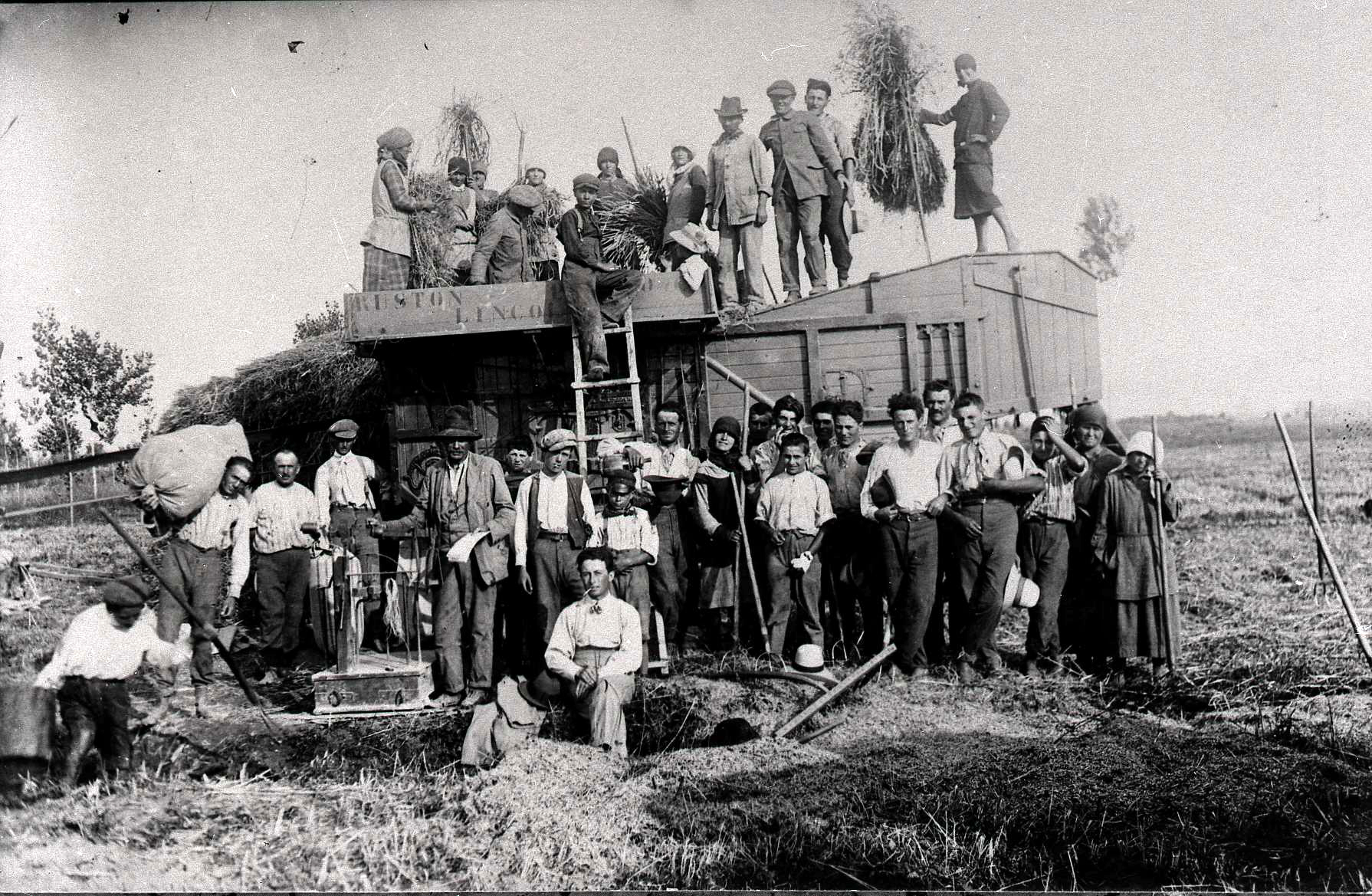Each family had its own corn field. In the end of June men organized teams of threshers who opened the long season of hard work, that ended with the threshing.
The sheaves, gathered in piles (capale e capalòt) in the fields, awaited the “macchina da bate”, that long and terrible machine that was to do the job. In the villages these machines couldn’t find places that were big enough to keep them, so they were left for days in the main square, and there they stayed, making a continuous noise, except for the short pauses that mendid in the night.
In the hot July air men were continuously beaten by dust and dross, while they threw the sheaves into the machines or took away from it the square straw bales (balòt). Near to the machine there were the big sacks full of corn grains, always kept under control by the owner of the field.
The hard work and the happiness of having a sure meal awaiting for all the next year were the cause of the big lunches, nutritive but not too heavy, because the workers had to keep working.Women started preparing the day before, and made filled tomatoes and sweets; the fields gave lots of vegetables and the chickens were ready. In this disné ‘d bate ‘l gran, a bit more complicated than the original, I propose some of those old recipes.For to start, the caponét and the tongue, both served tepid; then the soup of the bate ‘l gran, necessary to refreshen the throat after having breathen the dust from the corn; then the Marengo chicken. Dishes of which only little traces remain. Then we can continue with the Ginòta rabbit and end with the bonèt and the filled peaches.I think this is a menu that requires very good wines. With the hors d’oeuvre I recommend a lightly sparkling Freisa delle Langhe. Then the classical red wines of the Langhe and with the sweets some Moscato d’Asti.
Armando Gambera
A chemistry graduate from the University of Turin, he works as a secondary school chemistry teacher. For many years, he has focused his studies and research on the field of cookery, wine and cheese, especially those of the Langhe area of Italy. He contributes to Slow Food guides on the subject (‘Osteria d’Italia’, ‘Le Strade del Barolo’, ‘Barolo e Barbaresco’, ‘Guida delle Langhe e del Roero’, ‘Le ricette delle osterie di Langa’, ‘Formaggi d’Europa’). He has written books for the La Morra Municipal Cellar: ‘La cucina e i vini di La Morra’ (The cuisine and wine of La Morra), ‘La vigna in etichetta, storia del Barolo di La Morra’ (Vineyards in Labels, the History of La Morra Barolo). His monograph ‘La cucina di Alba nel Novecento’ (1900s Cuisine in Alba) features in the book edited by the Famija Albeisa, ‘Il grande libro della cucina di Alba’ (The Great Book of Alba Cuisine). He writes for magazines (Barolo & Co.; Slowfood; L’Assaggiatore; Itinerari in Piemonte). He is a Master Taster of cheeses and holds the position of Vice President of ONAF (National Organisation of Cheese Tasters); he holds lessons in wine and cheese tasting and organises cookery courses held in restaurants throughout Langa. His cookery courses have given rise to two recipe books: ‘Cucinando col vino’ (Cooking with Wine) and ‘Cucina d’autunno’ (Autumn Cooking).
---------------------------------
Laureato in chimica presso l’Università di Torino, è professore di chimica nelle scuole superiori. Da parecchi anni si dedica allo studio e alla ricerca nel campo della cucina, dei vini e dei formaggi, in particolare delle Langhe. Collabora alle guide del settore pubblicate dallo Slow Food ("Osteria d’Italia", "Le strade del Barolo", "Barolo e Barbaresco", "Guida delle Langhe e del Roero", "Le ricette delle osterie di Langa", "Formaggi d’Europa"). Per la Cantina Comunale di La Morra ha scritto i libri: "La cucina e i vini di La Morra", "La vigna in etichetta, storia del Barolo di La Morra". Su "Il grande libro della cucina di Alba", edito dalla Famija Albeisa, compare la sua monografia "La cucina di Alba nel Novecento". Scrive su alcune riviste (Barolo & Co.; Slowfood; L’Asssaggiatore; Itinerari in Piemonte). E’ Maestro Assaggiatore di formaggi e ricopre la carica di Vicepresidente dell’ONAF (Organizzazione Nazionale Assaggiatori di Formaggi); tiene lezioni di degustazione dei vini e dei formaggi, organizza corsi di scuola di cucina presso i ristoranti di Langa. Dai corsi di cucina ha tratto due ricettari: "Cucinando col vino" e "Cucina d’autunno".
Posts by Armando
|

